Diptera.info :: Miscellaneous :: General queries
|
Home Made Traps
|
|
| Gordon |
Posted on 13-10-2009 07:10
|
|
Member Location: Lake Kerkini, Greece Posts: 1101 Joined: 02.01.08 |
I thought, after Andre's shout, that probably many entomologists make their own traps, so maybe we can collect info, ideas and experiences here.
Edited by Gordon on 13-10-2009 07:11 |
| Gordon |
Posted on 13-10-2009 08:07
|
|
Member Location: Lake Kerkini, Greece Posts: 1101 Joined: 02.01.08 |
So I will start with my experiences of making malaise traps. I found three main problems trying to copy a traditiona malaise trap and reduce costs as much as possible. The first was finding a suitable material, in Greece you cannot buy the tradition B/W netting. I ended up finding a shop that sells remnant cloth and getting some fine weave blue curtain material, it was cheap and did the trick, but it was stretchy (slightly elastic). I chose blue because I thought it might work, might look like the sky and encourage insects to fly up. You want to buy the material cheap because it will only last a year, at least in the Greek/Mediterranean sun. The second getting the material cut and sewn, of course if I had a wife/sister/mother/daughter with a sewing machine closer than 1500 km it might have been easier. But really its just a matter of care and good measuring and good scissors, because none of the angles are right angles you have to cut across the weave. Despite a lot of the literature I found that a few creases or sags did not really make much difference so it didn't matter that the sewing was not perfect. The most difficult part was making the collecting bottle. I tried several mediocre methods before hitting on plastic chocolate/nut spread jars - clear plastic, wide mouth and good thread on the cap (and available anywhere), and down pipe. The plastic water pipe for plumbing. In the picture you can see the side connecting to the trap is a piece of downsisizing connection pipe, one part fits around the bottle and the other part angles down and has a reduced diametre to wich the net is afixed. The down pipe is not the exact fit of the bottle, so it is cut away at the back and it is flexible. A second piece is attached at the back with a jubilee clip through it to attache the whole thin to a post. All the parts are cut down to maximise the light passing through it and are gluued and rivited together. The caps/lids of the bottles are cut away mostly on the top and glues back to back, then a strip of strong material is glued around the outside. In Greece you can make a full sized malaise trap like this for about 25 Euroe plus the cost of the sewing, and you have a lot of chocolate to enjoy, or, as I did, give away. Gordon attached the following image: 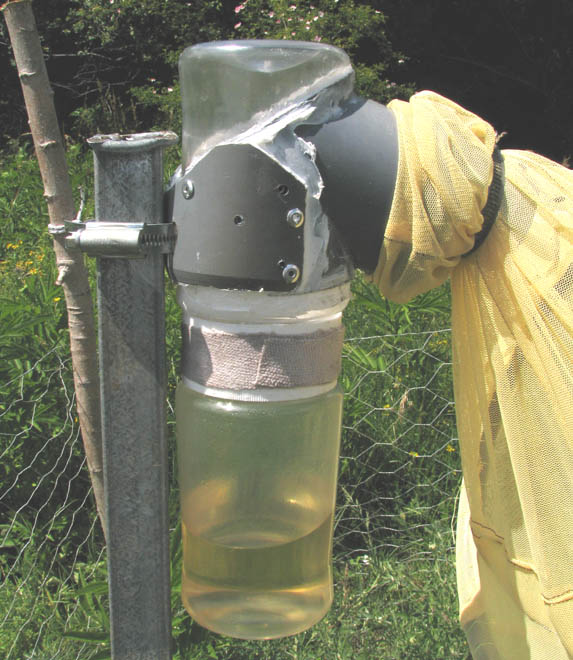 [101.8Kb] Edited by Gordon on 13-10-2009 09:12 |
| Gordon |
Posted on 13-10-2009 08:55
|
|
Member Location: Lake Kerkini, Greece Posts: 1101 Joined: 02.01.08 |
I should go on record as saying I tried other designs with no success. The trap in the image below was designed to mimic some small Czech-designed traps we bought, the idea of the wooden frames was that it would keep the cloth taught, and all the cloth to be replaced every year or so without the need for sewing. For reasons I do not really understand, except maybe that the small Czech traps are no good in open areas it did not work at all(they worked well at Ramna, middlingly at Farfara and poorly at Stratiom - suggesting again how important trap location can be - but I did get to compare them directly with a full malaise by changing from one to the other at the Cafe Elodia site, and they catch a lot less). Strangely this trap also collected water, somehow the bottle food fill up during the week, even if it didn't rain, I have no idea why, but I suspect the wood had something to do with it. Gordon attached the following image: 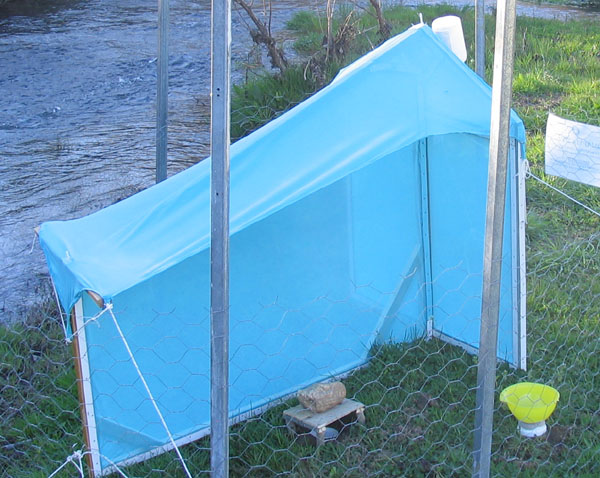 [106.11Kb] |
| Gordon |
Posted on 13-10-2009 09:11
|
|
Member Location: Lake Kerkini, Greece Posts: 1101 Joined: 02.01.08 |
Finally to the cone traps. I made these to be suspended over small streams in the mountain, then never used them like this, the idea being that the insects could not simply fall out as they would from a malaise suspended over water. I made two, the blue one used at Sultanitsa site and the Y#yellow one used at Helicopter, I was interested here in impersonating a giant flower. Sadly my brain wasn't working the day I bought the cloth for the yellow one and I bought too large mesh, so microhyms and such could just walk through the holes, I didn't notice this until the day I was putting it up. The blue one worked excellently, catching loads of stuff. The yellow not so well, but again I think placement was a lot of the problem. I think they would work best where I designed them to go, over a small stream, with light behind them if possible. The Sultanitsa (blue) certainly was a success. See the taached phot of it in place. They had the same catching bottle arrangement as the home-made malaise. I used domestic hot-water piping to make the support hoops, a bit of pipe, with a longitudinal strip cut out and glue, was used to connect the two open ends. I think maybe a wider mouth might have been better. I drilled holes through hoop (and cut them through the cloth) to insert wire to which the supporting string/rope was attached, (3 on the larger hoop) this allowed complets control of the traps placement. Gordon attached the following image: 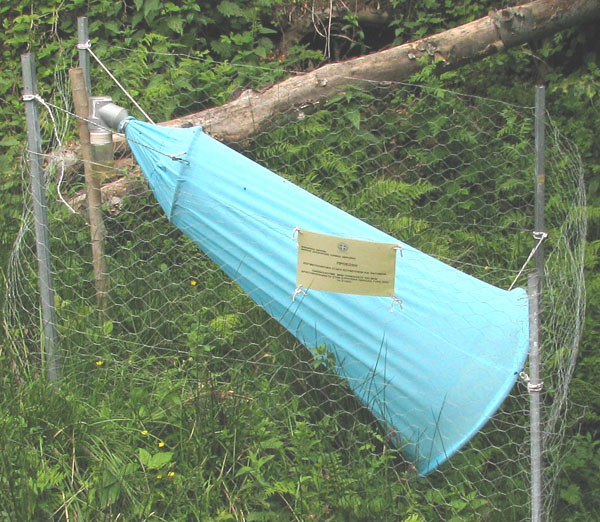 [137.34Kb] |
| Gordon |
Posted on 13-10-2009 09:24
|
|
Member Location: Lake Kerkini, Greece Posts: 1101 Joined: 02.01.08 |
Finally to repeat what I have already put in another thread on Malaise traps, the proof of success. The attached photo shows the catch from seven traps for one week. While comparing the amount of the catch of the Sultanitsa cone-trap with the other traps please note the following. 1) Midway and Beabies were full sized tradional malaise traps in open stiuations. Also Midway contains a lot of Lepidoptera and Orthoptera once these were removed the catch was less than Beabies or Sultanitsa. The Bebies catch however was bulked up by Wood Ants (Formic sp.) and a single species of black Acalyptrate, slightly larger than a Housefly 2)Farfara, Ramna and Stratiom were all small size, open form, Czech desgn traps, the difference in catch represents difference in habitat and placement. Ramna was the most closed site, and the nearest to a stream 10cm. Farfara 2ms and Midway was on a dry sunny hillside. 3) Petritsi was a small home-made malaise in a sparsely vegetated area, beside a fast flowwing stream. Gordon attached the following image: 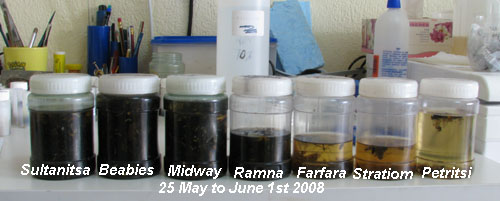 [44.59Kb] Edited by Gordon on 13-10-2009 09:26 |
| ChrisR |
Posted on 13-10-2009 09:40
|
|
Super Administrator Location: Reading, England Posts: 7706 Joined: 12.07.04 |
Nice work Gordon  Making your own trap certainly makes good economic sense because the stitching work needed to make the malaise 'tent' and the molded parts in the bottle are always costly to buy from dealers. Making your own trap certainly makes good economic sense because the stitching work needed to make the malaise 'tent' and the molded parts in the bottle are always costly to buy from dealers.  I notice the photo of the blue Malaise trap shows that it has very short 'roof' parts and a frame to create the shape. With my English designed one the roof parts are much longer - reaching down & out 1/3 to 1/2 of the height of the trap and this probably prevents insects from flying out. You can argue that higher-flying insects won't get in but I think most insects will skim over the ground or flowers anyway so I have never found it to be a problem. The higher-flying stuff tends to be butterflies and Odonata anyway. Also mine doesn't need any frame - but perhaps yours needed it because the fabric was stretchy? The only solid parts on mine are the front poll and a much shorter stick at the rear. The shape is just created by the guy-ropes and pegs. 
Manager of the UK Species Inventory in the Angela Marmont Centre for UK Biodiversity at the Natural History Museum, London. |
| Gordon |
Posted on 13-10-2009 11:05
|
|
Member Location: Lake Kerkini, Greece Posts: 1101 Joined: 02.01.08 |
Chris lets have a photo of yours, a picture ....1000 words and all that??? I post in here a photo of one of the small, open-form Czech traps, these came with no collecting bottle, just the bag bit and a elasticated holder at the end, they lose alcohol very quickly, I combatted this by covering the bag part in plastic, I also inserted a plastic ring to hold the mouth open and added a jubilee clip to the bottle cap to stop it falling out. You can see they are even more open than my wooden frame trap. Gordon attached the following image: 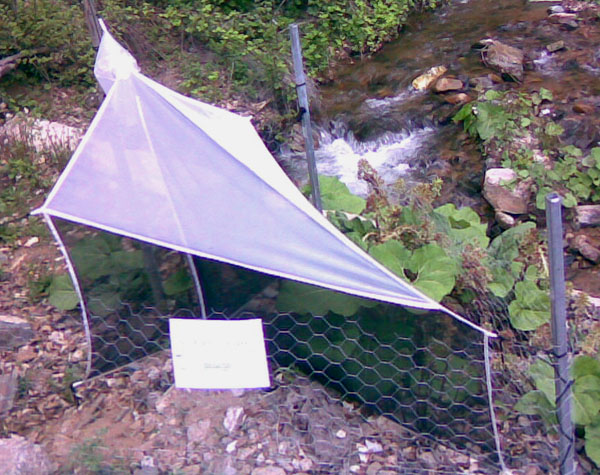 [122.4Kb] Edited by Gordon on 13-10-2009 11:06 |
| ChrisR |
Posted on 13-10-2009 11:27
|
|
Super Administrator Location: Reading, England Posts: 7706 Joined: 12.07.04 |
Good point - I should have posted my photos  Here is my webpage about Malaise trapping - showing my English traps. Here is my webpage about Malaise trapping - showing my English traps. Here are the main photos:   It stands about 180cm tall at the tallest part. The front is held up by a free-standing wooden pole and the back is braced against a shorter stick. But overall the tension and strength all come from guy-ropes pegged into the ground. 
Edited by ChrisR on 13-10-2009 11:29 Manager of the UK Species Inventory in the Angela Marmont Centre for UK Biodiversity at the Natural History Museum, London. |
| Gordon |
Posted on 13-10-2009 11:35
|
|
Member Location: Lake Kerkini, Greece Posts: 1101 Joined: 02.01.08 |
Chris - note that the wooden frome trap was a failure in two different sites. The first Malaise trap I made was based on the standard design and was a success. See Photo.
Gordon attached the following image: 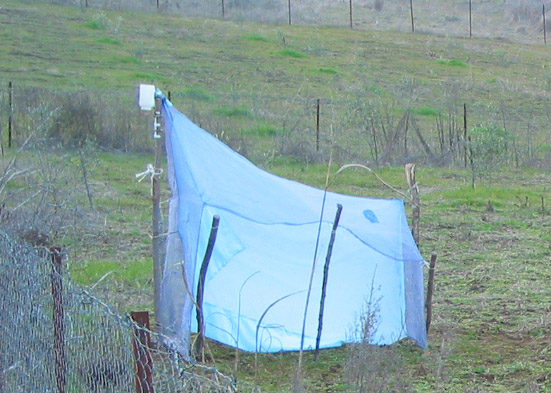 [100.88Kb] |
| Gordon |
Posted on 13-10-2009 11:46
|
|
Member Location: Lake Kerkini, Greece Posts: 1101 Joined: 02.01.08 |
Yes Chris, yours is what I call the standard design, this is my Midway trap, even placed contrariwise to advice (albeit this photo is late in the day), it caught an awful lot of stuff. I took over 1100 beetles out of it one week, the flies were named 'Legion'
Gordon attached the following image:  [105.33Kb] |
| ChrisR |
Posted on 13-10-2009 11:47
|
|
Super Administrator Location: Reading, England Posts: 7706 Joined: 12.07.04 |
The last blue-trap photo does look more 'standard' ... I think I might have the 'roof' down a bit lower still but it looks good. The habitat looks a bit 'bleak' though 
Edited by ChrisR on 13-10-2009 11:49 Manager of the UK Species Inventory in the Angela Marmont Centre for UK Biodiversity at the Natural History Museum, London. |
| ChrisR |
Posted on 13-10-2009 11:51
|
|
Super Administrator Location: Reading, England Posts: 7706 Joined: 12.07.04 |
Ahh, yes the black & white is a good design - mine trap a lot of insects. I wonder then if it is the different colour of sides & roof and whether the lower roof helps retain things?
Manager of the UK Species Inventory in the Angela Marmont Centre for UK Biodiversity at the Natural History Museum, London. |
| Gordon |
Posted on 13-10-2009 11:58
|
|
Member Location: Lake Kerkini, Greece Posts: 1101 Joined: 02.01.08 |
For those who might be interested to know, there is a large format Czech desgn malaise trap, same dimensions as the English design, but it comes with its own set of aluminium poles (See Photo). The entrance into the collecting bottle (from the tent) is a better desgn and it catches loads, but it has a problem with the bottles in that the connector between the two has been broken almost from day one in both this example and one that the NHM London used. In the end, with mine, I reconnected the frame/tent part to a different set of bottles.
Gordon attached the following image: 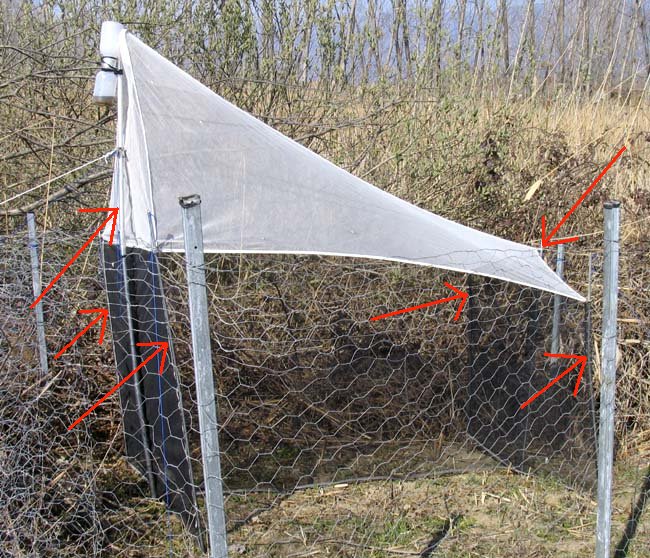 [142.65Kb] |
| Gordon |
Posted on 13-10-2009 12:02
|
|
Member Location: Lake Kerkini, Greece Posts: 1101 Joined: 02.01.08 |
Yes, the habitat was bleak (photo taken in early March). The trap had already been vandalised twice in another site despite having an animal fence around it. so it was moved here, into a friends olive orchard, to catch something without being destroyed. The vegetation did grow up, and there was a lot of scrub immediately behind it. But yes it wasn't the best site by a long way, in fact probably the worst. |
| Steve Pelikan |
Posted on 15-10-2009 03:41
|
|
Member Location: Ohio, U.S.A. Posts: 56 Joined: 24.06.06 |
I've attached a photo of a Malaise trap that I run frequently in our partially wooded but basically urban yard. It was stitched up for me by a friend based on a pattern that I drew but is basically a copy of another trap that I bought from a US supplier called "Bioquip". They're VERY good and helpful. The main issue with the design seems to be coupling the collecting head to the trap. In this model I used a 4-inch PVC plumbing coupler bolted onto a vertical pipe that supports the front of the trap. Into one end of it I sewed the cloth of the trap (covering the entire dodging junction with "duct tape"  and into the other of which a variety of 4-inch things can be placed. and into the other of which a variety of 4-inch things can be placed.Most often I use plastic "2 liter" soda pop bottles (4 inch diameter). With these I cut off the top, reverse it, and insert it into the bottom to serve as a sort of funnel. They're cheap and easy so I use several in a day so that I can tell what was collected in the AM, 12-4 and after 4PM (say). At home I pop them in the freezer. In the field, I put a little Ethyl Acetate on a twist of absorbent paper and pop it into the bottle for a while before transferring the bugs to a killing jar or a jar I can put on ice. I've used the PVC - plastic bottle device with some success for emergence traps and on cardboard boxes I can drop over bits of carrion. But I'd be very interested in hearing how other people do this sort of thing. Steve Pelikan attached the following image: 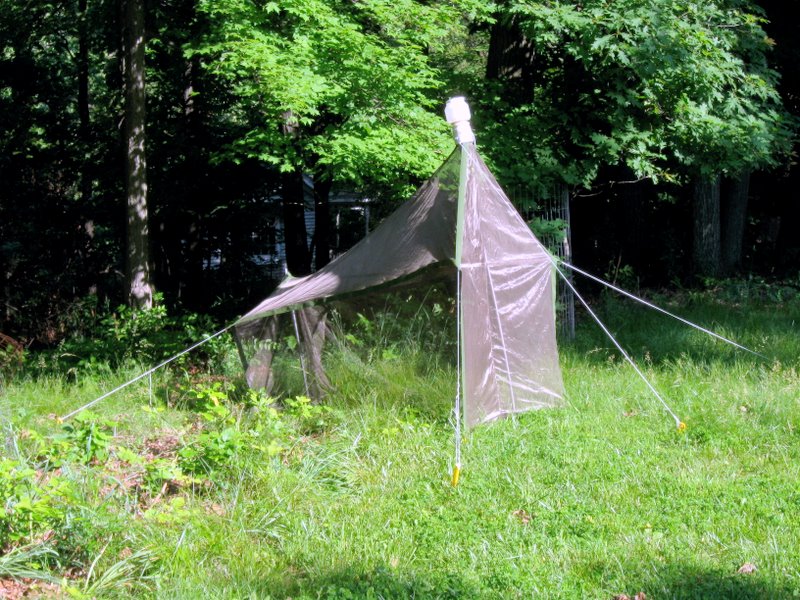 [177.26Kb] |
| viktor j nilsson |
Posted on 15-10-2009 21:43
|
|
Member Location: Gothenburg, Sweden Posts: 203 Joined: 25.02.08 |
This is a nice thread! I have experimented a little bit this summer (or rather, end of the summer...) with baited canopy traps. This is my very own, modified version of the Oulu trap, a great finnish invention which in it self is a modification of another finnish invention called the Jalas trap. The idea is simple: you have the bait inside the bucket, and try to make sure that the insects get into the bucket - but cannot escape. In my model I have filled the bottom of the bucket with about 5 cm of propylene glycol as a collecting medium. viktor j nilsson attached the following image: 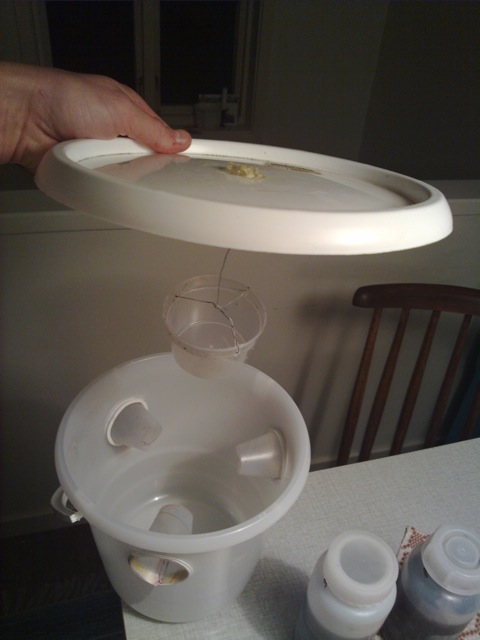 [56.18Kb] Edited by viktor j nilsson on 15-10-2009 21:55 |
|
|
|
| viktor j nilsson |
Posted on 15-10-2009 21:57
|
|
Member Location: Gothenburg, Sweden Posts: 203 Joined: 25.02.08 |
They actually costed me a bit to build (I built ten of them), about 90€. The 5L bucket with lid is something like 4€ each, the bait (bananas, sugar, wine, beer, year, syrup, apple) was something like 20€ in total. I made the entrance funnels by cutting out pieces of suitable shape from stiff transparent plastic that where supposed to be used for having under your plate at the dinner table! I needed two of those plastic sheets - 4€. I folded the cut-out plastic pieces into tapering tubes and "sewed" them together with steel wire (this was the toughest and, admittedly, least elegant, part). At first I attached the funnels to the buckets with silicone gel, but this was not very effective and I realized that since the funnels themselves tend to expand, I could simply attach them by putting strips of elastic window isolation bands between it and the bucket:
viktor j nilsson attached the following image: 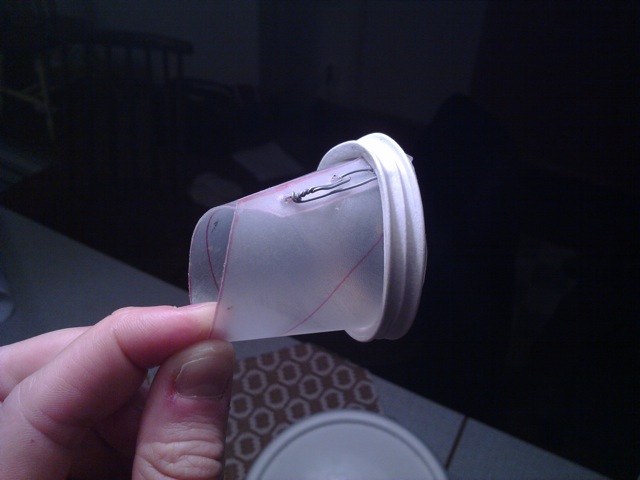 [51.25Kb] |
|
|
|
| viktor j nilsson |
Posted on 15-10-2009 21:57
|
|
Member Location: Gothenburg, Sweden Posts: 203 Joined: 25.02.08 |
The cups to have the bait in I stole from work. I raised the traps up into the canopy (5-6m height) at the summit of a nice little hill which has recently became a nature reserve, here at 65 degrees north in Sweden, at about 250 m above sea level. The hill is covered with old-growth boreal forest with large, standing, rotting aspen, birch and spruce. Here you can see the trap together with the catch that I got after about a month (each bottle is the catch from one trap - I had a total of six traps active at this one site since I did not expect them to be so efficient!). viktor j nilsson attached the following image: 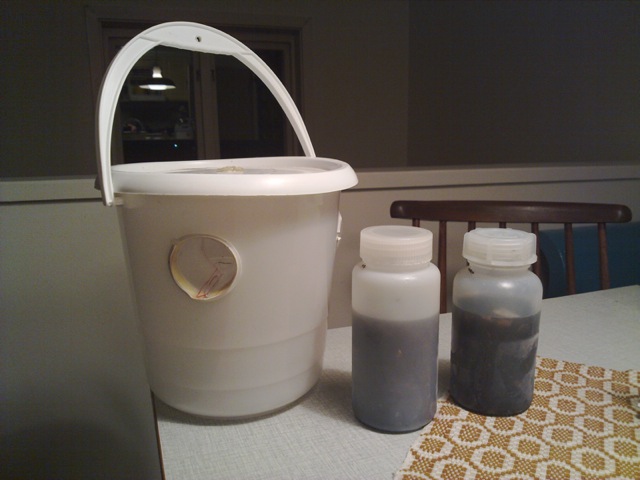 [67Kb] |
|
|
|
| Gordon |
Posted on 16-10-2009 11:12
|
|
Member Location: Lake Kerkini, Greece Posts: 1101 Joined: 02.01.08 |
Ah, Victor, a nice design, but you wouldn't want to leave it out for a month in the 40C sun of Greece. Attached is a design I made for baited traps, its an adjustment of the well known bottle banana/wine/beer trap, but I have separated the bait from the killing fluid (I used 70% ethanol and emptied the traps once a week). In the picture the traps have banana in them, and it worked well, but you could put anuthing in them and I am planning to experiment. the smell circulates well, as the containers have mesh on the top (the centre of the lid is cut away) you have to replace the mesh occasionally as ants will cut through it. By removing one of the aluminium bars you can remove the bait container. The aluminium is from electricity wire, I collected one metre sections left behind by repair men, the mesh is left over from making the malaise traps and I got the small bottles from the national park npeople so all I had to buy was the coke, which I drink anyway, and the bait. With a god arm and a long piece of string with a weight on the end you can get them well pu into a tree. Gordon attached the following image: 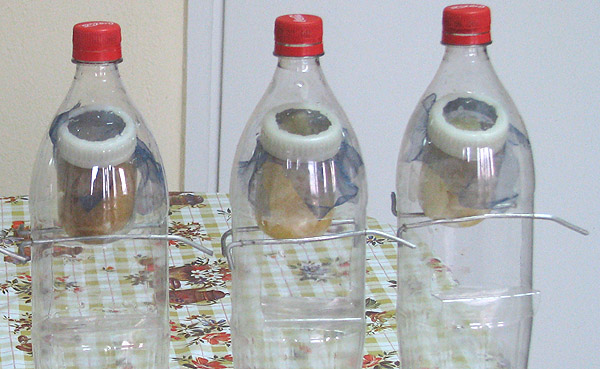 [95.61Kb] |
| Jump to Forum: |













